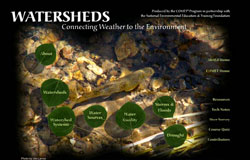Watersheds: Connecting Weather to the Environment
Earth Gauge™ is an initiative by the National Environmental Education Foundation (NEEF) and the American Meteorological Society (AMS) to facilitate the evolution of broadcast meteorologists into "station scientists" who can help viewers make important connections between the weather report they're watching and the environment in which they live. Through Earth Gauge™, NEEF and AMS are providing education and training to help meteorologists "tell the story" to their viewers. One of the most important tools offered by Earth Gauge™ to prepare meteorologists for their role as "station scientists," is a suite of free online courses developed by the Cooperative Program for Operational Meteorology, Education & Training (COMET) that address the links between weather and environment. As a part of the Earth Gauge™ program, COMET, funded in part by U.S. EPA's Office of Wetlands, Oceans, and Watersheds, has produced online learning modules to facilitate this process. The free courses count toward continuing education credit through the AMS Certified Broadcast Meteorologist Program.
While originally developed for meteorologists, the topics covered in these courses are relevant to many watershed professionals and educators. Practitioners, students and members of the general public are encouraged to view the online learning modules.

The first course in the COMET training series, Watersheds: Connecting Weather to the Environment, is designed as a foundation for many of the ways that weather and the environment are connected. It demonstrates the combined effects that weather and human activities have on water quality, quantity, and ecosystem health. The course can be completed in about 2 hours and includes the following units:
- Unit 1: Watersheds
- Unit 2: Watershed Systems
- Unit 3: Water Sources
- Unit 4: Water Quality
- Unit 5: Storms and Floods
- Unit 6: Drought
You might also wish to take the second course, Weather and the Built Environment, which provides an overview of the evolution of our modern urban environment, with a focus on impacts on the watershed, air quality, climate, and local and severe weather events.
Note: The Web site requires that users register before accessing the course. Registration is free and simple. To hear the narration for the course, be sure that your computer has Adobe Flash Player, free software that may be downloaded from the Adobe Web site. This course uses Adobe® Flash® for navigation, animation, and presentation of multimedia elements. Additionally, most modules also provide a print version alternative for users that require special accessibility features (e.g., screen readers).
